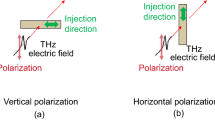Abstract
The quality of rubber products is strongly affected by the dispersion of the filler material and the vulcanization state; however, it is difficult to rapidly and nondestructively evaluate these conditions by conventional techniques. In this study, we investigated these properties with the use of THz radiation. Our examination of the THz spectroscopic characteristics of ingredients used in rubber products revealed that a typical filler material, carbon black (CB), has an extremely large apparent THz absorbance compared with those of other materials owing to the metal-like properties of CB. Through the use of this strong THz absorbance, the CB dispersion in rubber products was simply determined. We also evaluated a ruptured specimen from tensile tests. Through the use of the THz technique, we visualized a poorer CB dispersion at the ruptured section. We collected data on the crosslink densities in the rubber products created by vulcanization and were able to accurately evaluate their curing condition. We show that the THz absorbance was proportional to the crosslink density enabling rapid and nondestructive evaluation of the curing state.













Similar content being viewed by others
Change history
22 September 2022
A Correction to this paper has been published: https://doi.org/10.1007/s10762-021-00782-x
References
M. Tonouchi, Nature Photonics 1, 97 (2007).
T. Yasui, T. Yasuda, K. Sawanaka, T. Araki, App. Opt. 44, 6849 (2005).
A.J. Fitzgerald, B.E. Cole, P.F. Taday, J. Pharm. Sci. 94, 177 (2005).
O. Peters, S.F. Busch, B.M. Fischer, M. Koch, J. Infrared Milli Terahz Waves 33, 1221 (2012).
H. Hoshina, Y. Morisawa, H. Sato, A. Kamiya, I. Noda, Y. Ozaki, C. Otani, Appl. Phts. Lett. 96, 101904 (2010).
T. Okano, S. Watanabe, Sci. Rep. 6, 39079 (2016).
F. Xu, Q.D. Mu, L.J. Li, D. Yang, B. Xia, Fibres Text. East. Eur. 26, 67 (2018).
Y. Ikeda, Y. Yasuda, T. Ohashi, H. Yokohama, S. Minoda, H. Kobayashi, T. Honma, Macromolecules 48, 462 (2015).
Y. Hirakawa, J. Soc. Rubber Sci. and Techno. Jpn. [Nippon Gomu Kyokaishi] 90, 303 (2017) (in Japanese).
Y. Hirakawa, J. Soc. Rubber Sci. and Techno. Jpn. [Nippon Gomu Kyokaishi] 91, 375 (2018) (in Japanese).
A.Y. Cpran, in The Science and Technology of Rubber, 4th edn, ed. By J.E. Mark, B. Erman, M. Roland (Academic Press, Oxford, 2013), p. 337.
P.J. Flory, J. Rehner, J. Chem. Phys. 11, 521 (1943).
Y. Hirakawa, Y. Ohno, T. Gondoh, T. Mori, K. Takeya, M. Tonouchi, H. Ohtake, T. Hirosumi, J. Infrared Milli Terahz Waves 32, 1457 (2011).
Y. Hirakawa, T. Yamauchi, T. Kamino, T. Gondoh, S. Hirano, T. Noguchi, Technical Digests of the Conference on Lasers and Electro-Optics (CLEO) Optical Society of America (San Jose), ATh4B (2017).
Y. Hirakawa, Y. Ohno, T. Gondoh, T. Mori, T. Noguchi, M. Tonouchi, H. Ohtake, T. Hirosumi, Technical Digests of the 10th Conference on Lasers and Electro-Optics Pacific Rim (CLEO-PR 2013) (Kyoto), WPC-7 (2013).
Y. Yasumoto, Y. Hirakawa, T. Gondo, 2019 IOP Conf. Ser.: Mater. Sci. Eng. 548 012003 https://doi.org/10.1088/1757-899X/548/1/012003.
Acknowledgments
The authors thank Prof. M. Tonouchi of Osaka University, Japan and Dr. H. Ohtake of IMRA America for their technical advice and supports. We also appreciate Emeritus Prof. T. Mori of National Institute of Technology (KOSEN), Kurume College for his suggestions for the rubber samples, and Mr. T. Noguchi and Mr. S. Hirano of DAIKIN INDUSTRIES, Ltd., Japan for their providing samples. These experimental results are outcomes of all the members in our research group, including graduated students. We thank Mr. Frank Carbullido for editing a draft of this manuscript.
Funding
This study was partially supported by the 23rd and 28th Eno Foundation for the Advancement of Science and the Japan Society for the Promotion of a Science (JSPS) KAKENHI (Grant No. 24560056).
Author information
Authors and Affiliations
Corresponding author
Additional information
Publisher’s Note
Springer Nature remains neutral with regard to jurisdictional claims in published maps and institutional affiliations.
Rights and permissions
Springer Nature or its licensor holds exclusive rights to this article under a publishing agreement with the author(s) or other rightsholder(s); author self-archiving of the accepted manuscript version of this article is solely governed by the terms of such publishing agreement and applicable law.
About this article
Cite this article
Hirakawa, Y., Yasumoto, Y. & Gondo, T. Evaluation of Rubber Products by Terahertz Time-domain Spectroscopy. J Infrared Milli Terahz Waves 41, 414–429 (2020). https://doi.org/10.1007/s10762-019-00637-6
Received:
Accepted:
Published:
Issue Date:
DOI: https://doi.org/10.1007/s10762-019-00637-6




